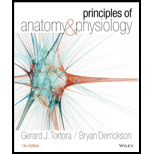
Principles of Anatomy and Physiology
14th Edition
ISBN: 9781118345009
Author: Gerard J. Tortora
Publisher: WILEY
expand_more
expand_more
format_list_bulleted
Question
Chapter 14, Problem 27CP
Summary Introduction
To review:
The precise sequence of the nerve cells involved in visual impulse processing within the retina
Introduction:
The retina is the terminal light-sensitive region present in the eyes of almost every vertebrate. This structure captures the two-dimensional image formed by the optical process of refraction and reflection within the eyes. The captured image is then converted into neural impulses and sent to the visual processing center of the brain to obtain a visual experience. The retina is primarily composed of rods, cones, and other accessory nerve conduction cells.
Expert Solution & Answer
Want to see the full answer?
Check out a sample textbook solution
Students have asked these similar questions
Briefly state the physical meaning of the electrocapillary equation (Lippman equation).
Explain in a small summary how:
What genetic information can be obtained from a Punnet square? What genetic information cannot be determined from a Punnet square?
Why might a Punnet Square be beneficial to understanding genetics/inheritance?
In a small summary write down:
Chapter 14 Solutions
Principles of Anatomy and Physiology
Ch. 14 - Compare the sizes and locations of the cerebrum...Ch. 14 - Prob. 2CPCh. 14 - Prob. 3CPCh. 14 - Prob. 4CPCh. 14 - Prob. 5CPCh. 14 - 6. Where are the medulla, pons, and midbrain...Ch. 14 - Prob. 7CPCh. 14 - Prob. 8CPCh. 14 - Describe the location and principal parts of the...Ch. 14 - 10. Where do the axons of each of the three pairs...
Ch. 14 - Prob. 11CPCh. 14 - Prob. 12CPCh. 14 - Prob. 13CPCh. 14 - Define a circumventricular organ.Ch. 14 - 15. List and locate the lobes of the cerebrum. How...Ch. 14 - Prob. 16CPCh. 14 - Prob. 17CPCh. 14 - Prob. 18CPCh. 14 - Prob. 19CPCh. 14 - Prob. 20CPCh. 14 - Prob. 21CPCh. 14 - Prob. 22CPCh. 14 - How are cranial nerves named and numbered?Ch. 14 - Prob. 24CPCh. 14 - Prob. 25CPCh. 14 - Prob. 26CPCh. 14 - Prob. 27CPCh. 14 - Prob. 28CPCh. 14 - Prob. 29CPCh. 14 - Prob. 30CPCh. 14 - Prob. 31CPCh. 14 - Prob. 32CPCh. 14 - Prob. 33CPCh. 14 - 34. Where do the motor axons of the accessory (XI)...Ch. 14 - Prob. 35CPCh. 14 - Prob. 36CPCh. 14 - Prob. 37CP
Knowledge Booster
Learn more about
Need a deep-dive on the concept behind this application? Look no further. Learn more about this topic, biology and related others by exploring similar questions and additional content below.Similar questions
- Not part of a graded assignment, from a past midtermarrow_forwardNoggin mutation: The mouse, one of the phenotypic consequences of Noggin mutationis mispatterning of the spinal cord, in the posterior region of the mouse embryo, suchthat in the hindlimb region the more ventral fates are lost, and the dorsal Pax3 domain isexpanded. (this experiment is not in the lectures).a. Hypothesis for why: What would be your hypothesis for why the ventral fatesare lost and dorsal fates expanded? Include in your answer the words notochord,BMP, SHH and either (or both of) surface ectoderm or lateral plate mesodermarrow_forwardNot part of a graded assignment, from a past midtermarrow_forward
- Explain in a flowcharts organazing the words down below: genetics Chromosomes Inheritance DNA & Genes Mutations Proteinsarrow_forwardplease helparrow_forwardWhat does the heavy dark line along collecting duct tell us about water reabsorption in this individual at this time? What does the heavy dark line along collecting duct tell us about ADH secretion in this individual at this time?arrow_forward
arrow_back_ios
SEE MORE QUESTIONS
arrow_forward_ios
Recommended textbooks for you
 Human Physiology: From Cells to Systems (MindTap ...BiologyISBN:9781285866932Author:Lauralee SherwoodPublisher:Cengage Learning
Human Physiology: From Cells to Systems (MindTap ...BiologyISBN:9781285866932Author:Lauralee SherwoodPublisher:Cengage Learning Principles Of Radiographic Imaging: An Art And A ...Health & NutritionISBN:9781337711067Author:Richard R. Carlton, Arlene M. Adler, Vesna BalacPublisher:Cengage Learning
Principles Of Radiographic Imaging: An Art And A ...Health & NutritionISBN:9781337711067Author:Richard R. Carlton, Arlene M. Adler, Vesna BalacPublisher:Cengage Learning Human Biology (MindTap Course List)BiologyISBN:9781305112100Author:Cecie Starr, Beverly McMillanPublisher:Cengage Learning
Human Biology (MindTap Course List)BiologyISBN:9781305112100Author:Cecie Starr, Beverly McMillanPublisher:Cengage Learning Biology (MindTap Course List)BiologyISBN:9781337392938Author:Eldra Solomon, Charles Martin, Diana W. Martin, Linda R. BergPublisher:Cengage Learning
Biology (MindTap Course List)BiologyISBN:9781337392938Author:Eldra Solomon, Charles Martin, Diana W. Martin, Linda R. BergPublisher:Cengage Learning

Human Physiology: From Cells to Systems (MindTap ...
Biology
ISBN:9781285866932
Author:Lauralee Sherwood
Publisher:Cengage Learning

Principles Of Radiographic Imaging: An Art And A ...
Health & Nutrition
ISBN:9781337711067
Author:Richard R. Carlton, Arlene M. Adler, Vesna Balac
Publisher:Cengage Learning

Human Biology (MindTap Course List)
Biology
ISBN:9781305112100
Author:Cecie Starr, Beverly McMillan
Publisher:Cengage Learning


Biology (MindTap Course List)
Biology
ISBN:9781337392938
Author:Eldra Solomon, Charles Martin, Diana W. Martin, Linda R. Berg
Publisher:Cengage Learning

Visual Perception – How It Works; Author: simpleshow foundation;https://www.youtube.com/watch?v=DU3IiqUWGcU;License: Standard youtube license